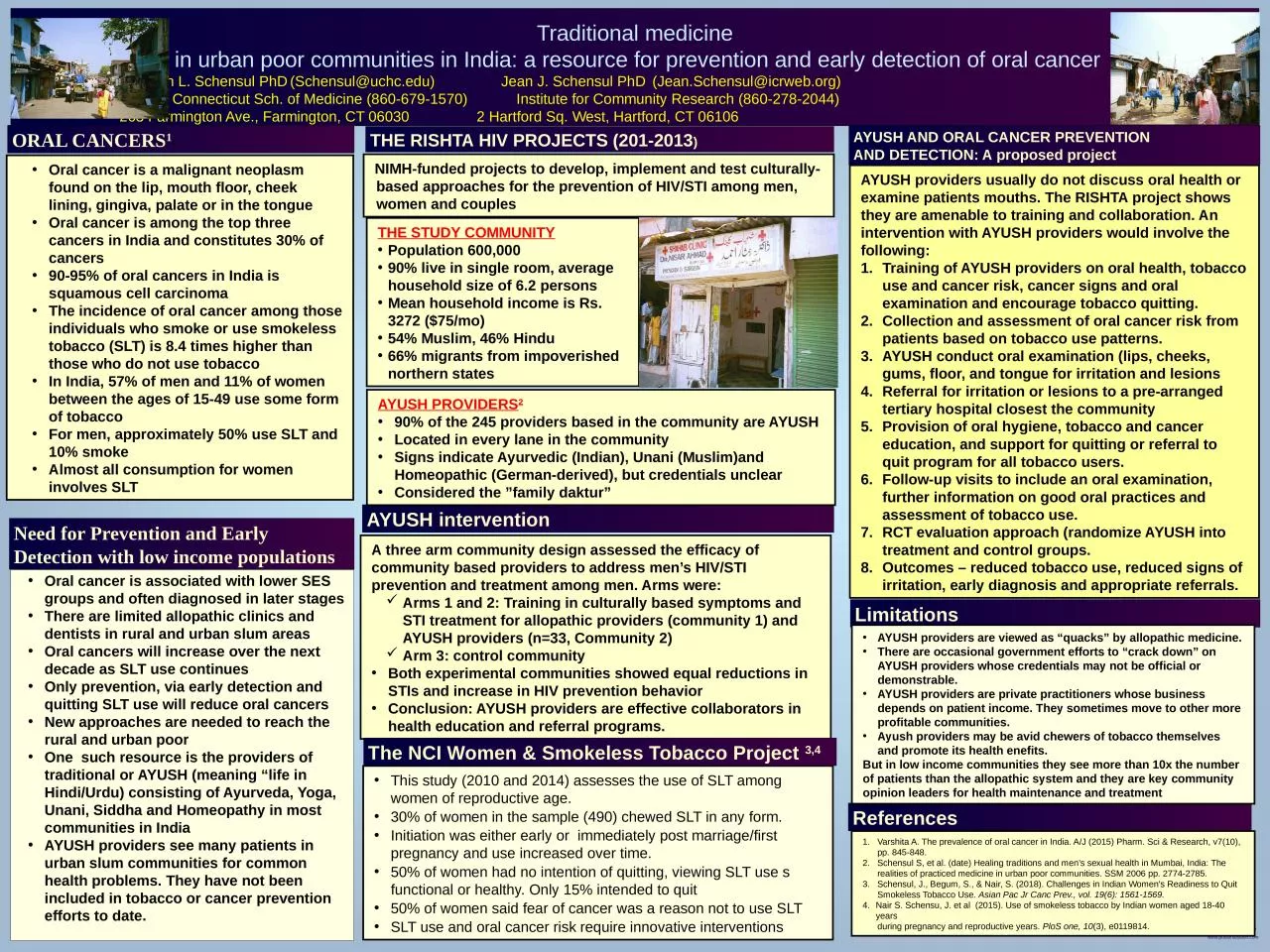

a resource for prevention and early detection of oral cancer Stephen L Schensul PhD Schensuluchcedu Jean J Schensul PhD JeanSchensulicrweborg ID: 915276
Download Presentation The PPT/PDF document "Traditional medicine in urban poor co..." is the property of its rightful owner. Permission is granted to download and print the materials on this web site for personal, non-commercial use only, and to display it on your personal computer provided you do not modify the materials and that you retain all copyright notices contained in the materials. By downloading content from our website, you accept the terms of this agreement.
Slide1
Traditional medicine in urban poor communities in India: a resource for prevention and early detection of oral cancer Stephen L. Schensul PhD (Schensul@uchc.edu) Jean J. Schensul PhD (Jean.Schensul@icrweb.org) Univ. of Connecticut Sch. of Medicine (860-679-1570) Institute for Community Research (860-278-2044) 263 Farmington Ave., Farmington, CT 06030 2 Hartford Sq. West, Hartford, CT 06106
Oral cancer is a malignant neoplasm found on the lip, mouth floor, cheek lining, gingiva, palate or in the tongueOral cancer is among the top three cancers in India and constitutes 30% of cancers90-95% of oral cancers in India is squamous cell carcinomaThe incidence of oral cancer among those individuals who smoke or use smokeless tobacco (SLT) is 8.4 times higher than those who do not use tobaccoIn India, 57% of men and 11% of women between the ages of 15-49 use some form of tobaccoFor men, approximately 50% use SLT and 10% smokeAlmost all consumption for women involves SLT
AYUSH providers usually do not discuss oral health or examine patients mouths. The RISHTA project shows they are amenable to training and collaboration. An intervention with AYUSH providers would involve the following:
Training of AYUSH providers on oral health, tobacco use and cancer risk, cancer signs and oral examination and encourage tobacco quitting. Collection and assessment of oral cancer risk from patients based on tobacco use patterns. AYUSH conduct oral examination (lips, cheeks, gums, floor, and tongue for irritation and lesionsReferral for irritation or lesions to a pre-arranged tertiary hospital closest the communityProvision of oral hygiene, tobacco and cancer education, and support for quitting or referral to quit program for all tobacco users. Follow-up visits to include an oral examination, further information on good oral practices and assessment of tobacco use.RCT evaluation approach (randomize AYUSH into treatment and control groups. Outcomes – reduced tobacco use, reduced signs of irritation, early diagnosis and appropriate referrals.
ORAL CANCERS11
THE RISHTA HIV PROJECTS (201-2013)
Limitations
References
THE STUDY COMMUNITYPopulation 600,00090% live in single room, average household size of 6.2 personsMean household income is Rs. 3272 ($75/mo)54% Muslim, 46% Hindu66% migrants from impoverished northern states
A three arm community design assessed the efficacy of community based providers to address men’s HIV/STI prevention and treatment among men. Arms were: Arms 1 and 2: Training in culturally based symptoms and STI treatment for allopathic providers (community 1) and AYUSH providers (n=33, Community 2)Arm 3: control communityBoth experimental communities showed equal reductions in STIs and increase in HIV prevention behavior Conclusion: AYUSH providers are effective collaborators in health education and referral programs.
AYUSH intervention
AYUSH providers are viewed as “quacks” by allopathic medicine.There are occasional government efforts to “crack down” on AYUSH providers whose credentials may not be official or demonstrable. AYUSH providers are private practitioners whose business depends on patient income. They sometimes move to other more profitable communities. Ayush providers may be avid chewers of tobacco themselves and promote its health enefits. But in low income communities they see more than 10x the number of patients than the allopathic system and they are key community opinion leaders for health maintenance and treatment
Need for Prevention and Early Detection with low income populations
NIMH-funded projects to develop, implement and test culturally-based approaches for the prevention of HIV/STI among men, women and couples
Varshita A. The prevalence of oral cancer in India. A/J (2015) Pharm. Sci & Research, v7(10), pp. 845-848.Schensul S, et al. (date) Healing traditions and men’s sexual health in Mumbai, India: The realities of practiced medicine in urban poor communities. SSM 2006 pp. 2774-2785.Schensul, J., Begum, S., & Nair, S. (2018). Challenges in Indian Women's Readiness to Quit Smokeless Tobacco Use. Asian Pac Jr Canc Prev., vol. 19(6): 1561-1569.Nair S. Schensu, J. et al (2015). Use of smokeless tobacco by Indian women aged 18-40 years during pregnancy and reproductive years. PloS one, 10(3), e0119814.
Oral cancer is associated with lower SES groups and often diagnosed in later stagesThere are limited allopathic clinics and dentists in rural and urban slum areasOral cancers will increase over the next decade as SLT use continuesOnly prevention, via early detection and quitting SLT use will reduce oral cancersNew approaches are needed to reach the rural and urban poorOne such resource is the providers of traditional or AYUSH (meaning “life in Hindi/Urdu) consisting of Ayurveda, Yoga, Unani, Siddha and Homeopathy in most communities in IndiaAYUSH providers see many patients in urban slum communities for common health problems. They have not been included in tobacco or cancer prevention efforts to date.
AYUSH AND ORAL CANCER PREVENTION
AND DETECTION: A proposed project
AYUSH PROVIDERS
2
90% of the 245 providers based in the community are AYUSH
Located in every lane in the community
Signs indicate Ayurvedic (Indian), Unani (Muslim)and Homeopathic (German-derived), but credentials unclearConsidered the ”family daktur”
This study (2010 and 2014) assesses the use of SLT among women of reproductive age. 30% of women in the sample (490) chewed SLT in any form. Initiation was either early or immediately post marriage/first pregnancy and use increased over time. 50% of women had no intention of quitting, viewing SLT use s functional or healthy. Only 15% intended to quit 50% of women said fear of cancer was a reason not to use SLTSLT use and oral cancer risk require innovative interventions
The NCI Women & Smokeless Tobacco Project
3,4